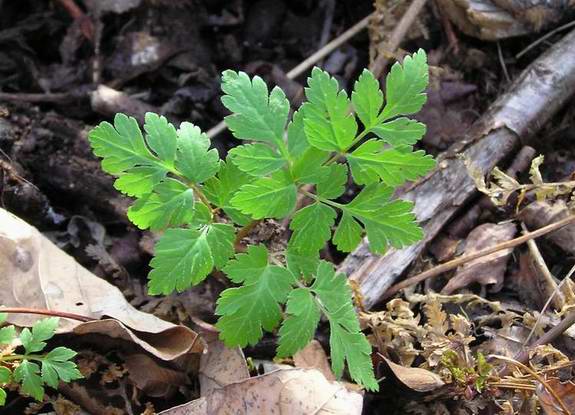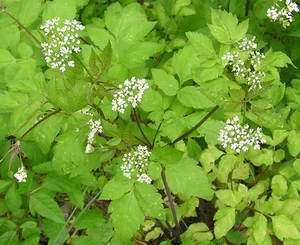|
Return to Hiker's Notebook Home Page Common Names: Sweet Cicely, sweet jarvil, and Aniseroot, sweet chervil - Cicely is an anglicized version of the Greek seselis which was a collective name for a group of plants with umbels, an arrangement in which the stalks of the (usually small) flowers extend from a single point or apex and are all about the same height. The Aniseroot has a licorice redolence similar to that of anise (Pimpinella anisum).
Scientific Names: Osmorhiza claytonii and O.
longistylis - The generic name is from the Greek words osme,
meaning odor and rhiza meaning root; the plants of the genus have
aromatic roots. John Clayton (1694-1773) was one of the early collectors of
plant specimens in Virginia; he was Clerk to the Gloucester County Court.
Longistylus means long styles (the style is the stalk of the pistil, the
female reproductive organ of the flower).
The USDA recognizes nine species in the genus Osmorhiza to which common names that are variations of either "sweet root" or "sweet cicely" are ascribed. Of these, O. claytonii which is most commonly called sweet cicely and O. longistylis, which is most commonly called aniseroot, are indigenous to the Southern Appalachians. From a distance, the two plants are very similar in appearance, particularly in the spring when the small white umbellated flowers are blooming.
The two species are distinguished according to three characteristic attributes. The most noticeable difference is that O. claytonii has hairs on the stem and is therefore sometimes called downy or wooly sweet cicely; O. longistylis has smooth stems and is occasionally called smooth sweet cicely. The second difference is that O. longistylis has, as its name attests, long styles so that the umbellated flowers extend further above the pistil; O. claytonii is also sometimes called O. brevistylus since it has shorter styles. The third difference is the characteristic smell of the root; O. longistylis has a very pungent smell similar to the licorice aroma of anise and is therefore most commonly called aniseroot, although it has a number of other olfactory names such as licorice root , scented root, and paregoric root (paregoric is a camphorated opiate that contains anise oil used in the treatment of diarrhea). The roots of O. claytonii have a more subtle aroma reminiscent of the tuberous root of the turnip. Both species have a barb at the end of the seed that facilitates dissemination by snagging on animal fur or human clothing.
Sweet cicely is international, as it is also the common name given to Myrrhis odorata, a plant of Western European provenance that is similar in appearance to the North American sweet cicelies; they are both members of Apiaceae or Umbelliferae - the Carrot or Parsley family. The scientific name of the European sweet cicely (the only member of the genus) also derives from its aromaticity. Myrrh is well known as one of the three gifts brought by the Magi to Bethlehem; it was used as an ingredient in incense and perfume. Odorata is from the Latin odoratus meaning scented. The so-called British myrrh was used extensively as a salad herb, the roots also affording some geriatric benefit "for old people that are dull and without courage; it rejoiceth and comforteth the heart and increaseth their lust and strength." It was used as a general medicinal tonic for respiratory ailments. O. claytonii is sometimes called Myrrhis claytonii.
American sweet cicely and Aniseroot are also edible. The leaves can be used as an aromatic additive to salad dishes, though they have a somewhat bitter aftertaste. As edible greens, they reflect their association with parsley (Petroselinum crispum), the namesake for the botanical family to which they belong. O. longistylis is also known as sweet chervil - chervil is an annual European herb similar to parsley (it is called bearded parsley) - due to its use as a potherb. Sweet jarvil, another common name of O. claytonii is of unknown origin, though it is likely that it is an Americanized version of chervil, chosen to distinguish the two plants according to their different tastes. In both cases, the adjective sweet is applied to convey their aromatic distinctiveness.
Native Americans employed sweet cicely and aniseroot as a treatment for a number of conditions. The most notable was as a soothing eyewash, necessitated by the prevalence of eye infections attributed to the frequent exposure to smoke. The Chippewa and the Ojibwa chewed the root to relieve throat soreness. The colonists subsequently adopted the Osmorhiza plants as folk medicine for the treatment of coughs and for use as an expectorant. The aromatic scent of the roots was also considered to be an aphrodisiac. Animals are allegedly attracted to the pungent root smells, notably cattle and sheep. In the lore of the Omaha and Ponca tribes, sweet cicely was used to lure wild horses. The active ingredients in sweet cicely are the phenylpropanoids anethole, which is the source of the anise aroma, and chavicol, a compound used as an odorant in perfumery. |

